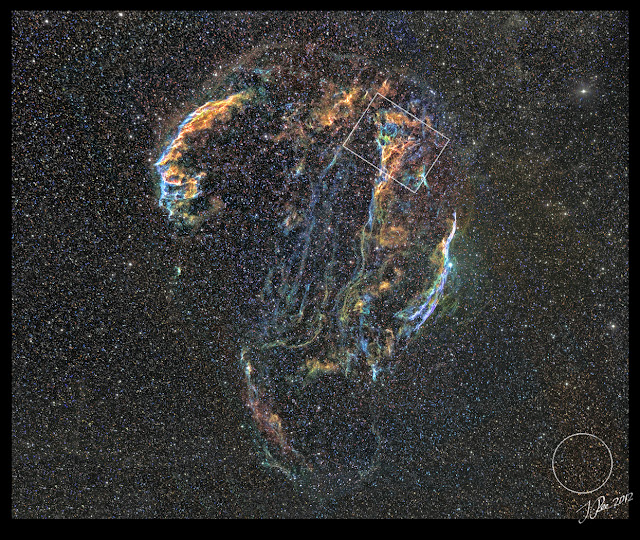COPYRIGHT, PLEASE NOTE
All the material on this website is copyrighted to J-P Metsavainio, if not otherwise stated. Any content on this website may not be reproduced without the author’s permission.
BUY A MUSEUM QUALITY POSTER
BUY A POSTER:https://astroanarchy.zenfolio.com/
Friday, November 9, 2012
Pickering's Triangle in Ha/OIII light
A somehow clear night for a long time!
Last night I was able to shoot O-III light (Light emitted by ionized oxygen.) for my latest project, the Pickering's Triangle in the Veil Nebula. I manged to collect three hours of O-III light, ones again clouds ruined about two hours of exposures. I'll shoot the S-II channel (Light emitted by ionized Sulfur.), as soon as the weather supports, for a three channel color image.
The Pickering's Triangle
A detail in the Veil Nebula supernova remnant
Two color image from H-a and O-III, image is in natural colors from narrowband channels. Emission of hydrogen can be seen as Red and emission of oxygen as Blue.
Pickering's Triangle is a small part of the Veil Nebula supernova remnant in constellation Cygnus.
Veil Nebula is a cloud of ionized gas and dust, leftovers from an exploded star. The star went off some 5000-8000 years ago at distance of about 1470 light years. This, relatively faint target, is difficult to image due to the large angular diameter, about three degrees, and a dense star field.
Orientation
Area of interest is marked as a white rectangle, the apparent size of the Moon can be seen at lower right corner.
An animated image
This animation shows the difference between H-a and O-III emissions.
Red = Hydrogen, Blue = Oxygen. The last image shows channels combined.
An experimental starless image
Sometimes I published starless images to show the actual nebula better.
Red = Hydrogen, Blue = Oxygen. The last image shows channels combined.
An experimental starless image
Sometimes I published starless images to show the actual nebula better.
Technical details:
Processing work flow:
Image acquisition, MaxiDL v5.07.
Stacked and calibrated in CCDStack2.
Levels, curves and color combine in PS CS3.
Optics, Meade LX200 GPS 12" @ f5
Camera, QHY9
Guiding, SXV-AO, an active optics unit, and Lodestar guide camera 8Hz
Image Scale, ~0,8 arc-seconds/pixel
15 x 1200s exposures for H-alpha emission = 5h
9 x 1200s exposures for O-III, emission of ionized oxygen = 3h
Ps.
This is my second Veil Nebula detail from this Autumn season. Previous photograph, IC 1340, can be seen here: http://www.astroanarchy.blogspot.fi/2012/10/ic-1340-project-finalized.html
Thursday, November 8, 2012
Meet your maker
"The creation of Adam"
An updated version of Michelangelo's fresco in Sistine Chapel ceiling, an original artwork from the year 1512
Info about the original fresco in Wikipedia: http://en.wikipedia.org/wiki/The_Creation_of_Adam
Meet your maker
We all are children of supernovae
The most common elements, like carbon and nitrogen, are created in the cores of most stars, fused from lighter elements like hydrogen and helium. The heaviest elements, like iron, however, are only formed in the massive stars which end their lives in supernova explosions. Even heavier elements are born in the extreme conditions of the explosion itself.
Without dying stars, life would not be possible. Our blood has iron in the hemoglobin which is vital to our ability to breath. We need oxygen in our atmosphere to breathe. Nitrogen enriches our planet's soil.
Without supernovae, we can have gas planets, stars and galaxies but not cars, cows, solid planets, humans or any life. We all are children of supernova explosions.
Simeis 147, a supernova remnant in constellation Taurus
Technical details and other info about the Simeis 147 (Sh2-240) can be seen in my blog post here:
I finalized this image at February 2012, the total exposure time is about 30h.
Tuesday, November 6, 2012
A Chinese Dragon
Chinese Dragon Nebula in constellation Cygnus

Click for a large image

Click for a large image
The very large, 18-panels, mosaic of the Cygnus was my main work at Autumn season 2011.
I named it to the Chinese Dragon Nebula due to reason seen in the image above.
Image spans 22 degrees horizontally. (22 degrees = 44 full Moons side by side in the sky)
http://astroanarchy.blogspot.fi/2011/12/cygnus-mosaic-18-panels-and-22-x-14.htmlHeart and Soul Nebulae, reprocessed
Since the weather up here has been less than supportive for astronomical imaging for a long time, I have played with an older data.
Heart & Soul Nebulae
IC1805 & IC1848
Image is in HST-palette, (HST=Hubble Space Telescope) from the emission of ionized elements,
R=Sulfur, G=Hydrogen and B=Oxygen.
Star colors are mixed from the NB channels, Red=H-a, G=O-III and B= 85%O-III + 15%H-a.
My photos, from several years, are used to combine this panoramic image of IC 1805 & 1848.
This emission nebula area is located in constellation Cassiopeia at distance of about 7500 light years.
I have made a scale study to show the apparent scale in the sky, it can be seen here:
Image is in visual spectrum, mixed from the same narrowband material, than image above.
Images used for the panorama with technical details
Subscribe to:
Posts (Atom)


















